
Chapter 17 Rearrangement of DNA 清革大当
Chapter 17 Rearrangement of DNA

17.1 Introduction 17.2 The mating pathway is triggered by pheromone-receptor interactions 17.3 The mating response activates a G protein 17.4 Yeast can switch silent and active loci for mating type 17.5 The MAT locus codes for regulator proteins 17.6 Silent cassettes at HML and HMR are repressed 17.7 Unidirectional transposition is initiated by the recipient MAT locus 17.8 Regulation of HO expression 17.9 Trypanosomes switch the VSG frequently during infection 17.10 New VSG sequences are generated by gene switching 17.11 VSG genes have an unusual structure 17.12 The bacterial Ti plasmid causes crown gall disease in plants 17.13 T-DNA carries genes required for infection 17.14 Transfer of T-DNA resembles bacterial conjugation 17.15 Selection ofamplified genomic sequences 17.16 Transfection introduces exogenous DNA into cells 17.17 Genes can be injected into animal eggs 17.18 ES cells can be incorporated into embryonic mice 17.19 Gene targeting allows genes to be replaced or knocked out 清菜大当
17.1 Introduction 17.2 The mating pathway is triggered by pheromone-receptor interactions 17.3 The mating response activates a G protein 17.4 Yeast can switch silent and active loci for mating type 17.5 The MAT locus codes for regulator proteins 17.6 Silent cassettes at HML and HMR are repressed 17.7 Unidirectional transposition is initiated by the recipient MAT locus 17.8 Regulation of HO expression 17.9 Trypanosomes switch the VSG frequently during infection 17.10 New VSG sequences are generated by gene switching 17.11 VSG genes have an unusual structure 17.12 The bacterial Ti plasmid causes crown gall disease in plants 17.13 T-DNA carries genes required for infection 17.14 Transfer of T-DNA resembles bacterial conjugation 17.15 Selection of amplified genomic sequences 17.16 Transfection introduces exogenous DNA into cells 17.17 Genes can be injected into animal eggs 17.18 ES cells can be incorporated into embryonic mice 17.19 Gene targeting allows genes to be replaced or knocked out
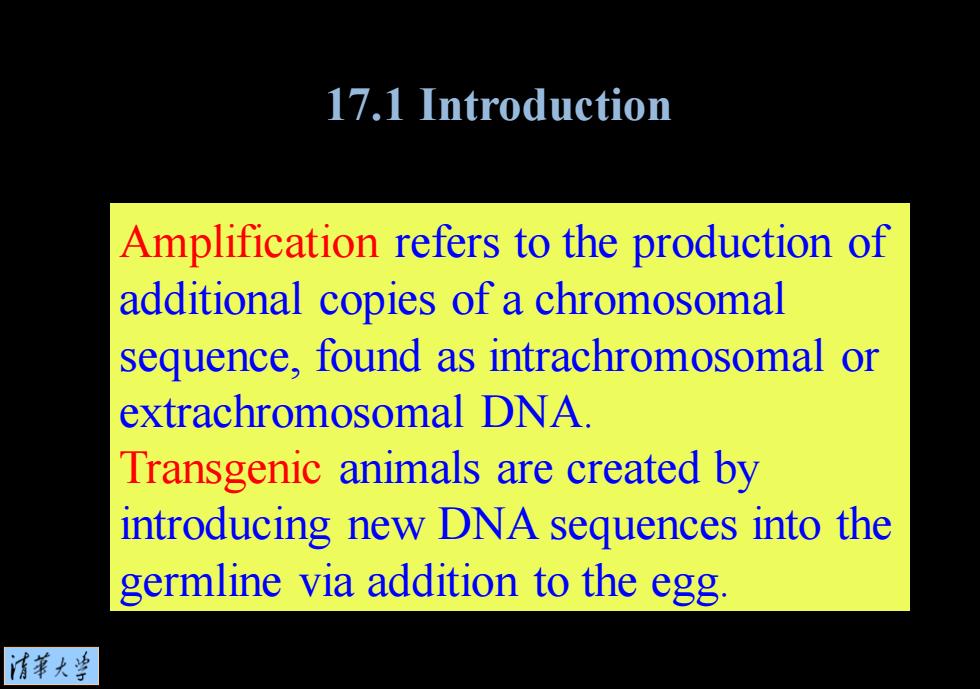
17.1 Introduction Amplification refers to the production of additional copies of a chromosomal sequence,found as intrachromosomal or extrachromosomal DNA. Transgenic animals are created by introducing new DNA sequences into the germline via addition to the egg. 清苇大兰
Amplification refers to the production of additional copies of a chromosomal sequence, found as intrachromosomal or extrachromosomal DNA. Transgenic animals are created by introducing new DNA sequences into the germline via addition to the egg. 17.1 Introduction
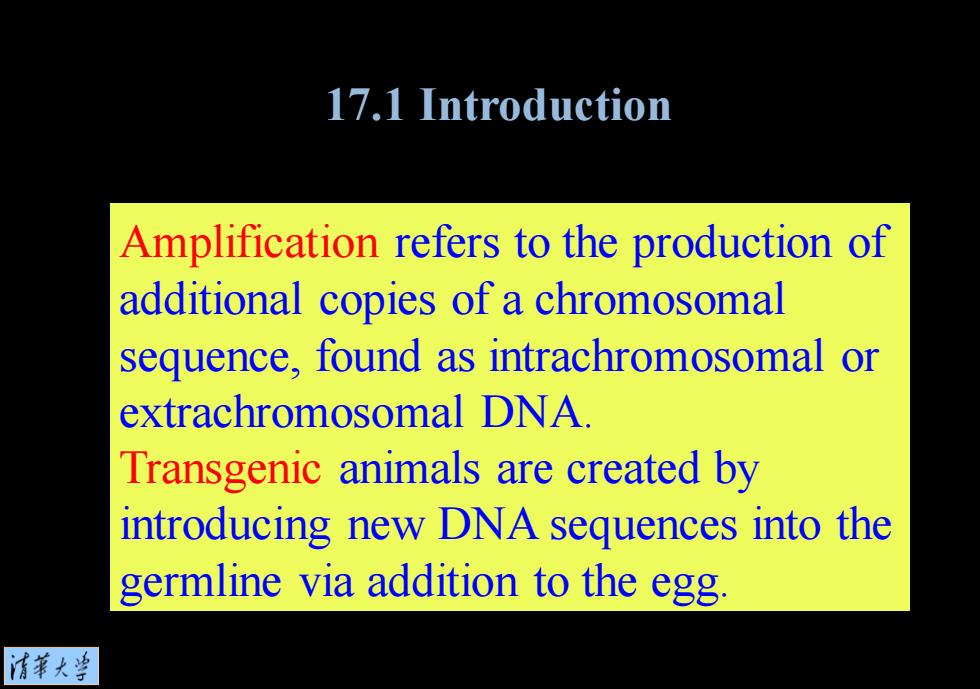
17.1 Introduction Amplification refers to the production of additional copies of a chromosomal sequence,found as intrachromosomal or extrachromosomal DNA. Transgenic animals are created by introducing new DNA sequences into the germline via addition to the egg 情菜大当
Amplification refers to the production of additional copies of a chromosomal sequence, found as intrachromosomal or extrachromosomal DNA. Transgenic animals are created by introducing new DNA sequences into the germline via addition to the egg. 17.1 Introduction
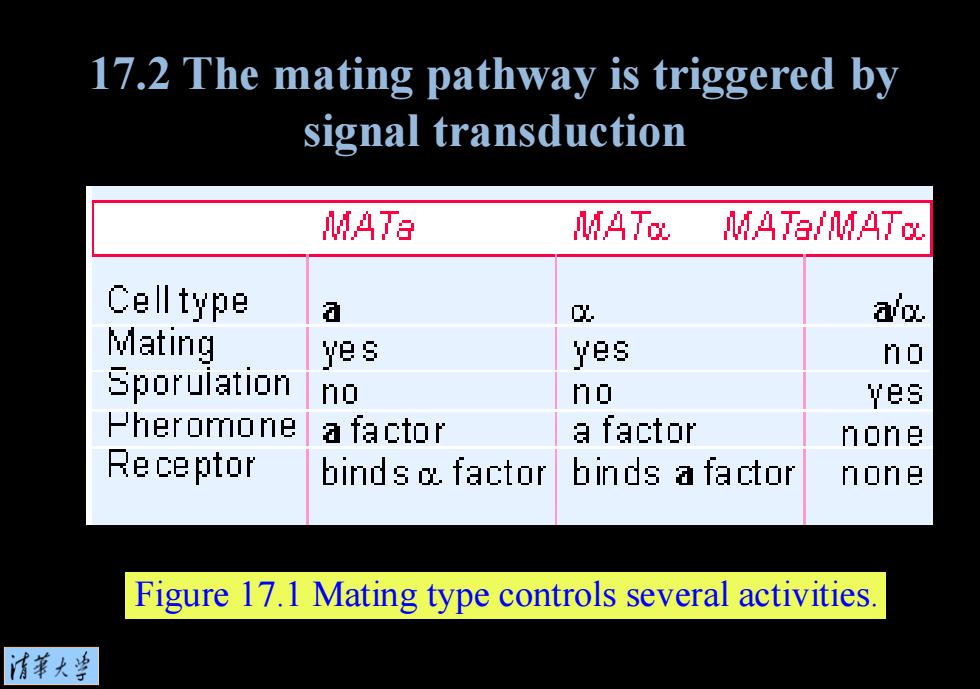
17.2 The mating pathway is triggered by signal transduction MATa MATo MATa/MATo Celltype a 以 alc Mating yes yes no Sporuiation no no ves Pheromone a factor a factor none Re ceptor bind s o factor binds a factor none Figure 17.1 Mating type controls several activities. 清苇大当
Figure 17.1 Mating type controls several activities. 17.2 The mating pathway is triggered by signal transduction
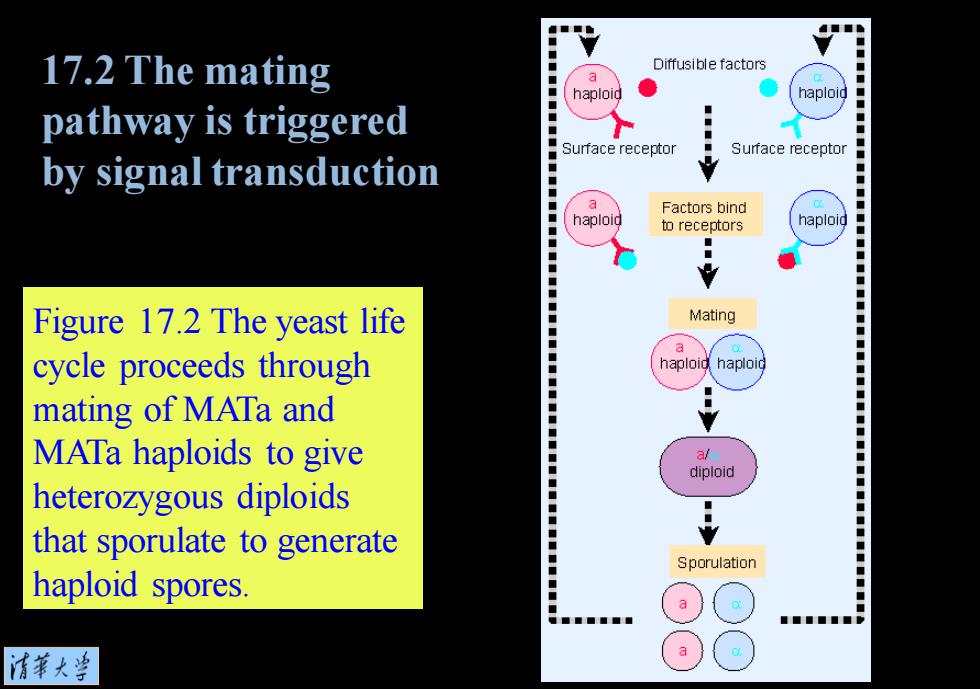
17.2 The mating Diffusible factors haploid haploid pathway is triggered Surface receptor Surface receptor by signal transduction Factors bind haploid to receptors haploid ■ Figure 17.2 The yeast life Mating cycle proceeds through haploid mating of MATa and MATa haploids to give diploid heterozygous diploids ◆ that sporulate to generate Sporulation haploid spores. ■ 情華大当
Figure 17.2 The yeast life cycle proceeds through mating of MATa and MATa haploids to give heterozygous diploids that sporulate to generate haploid spores. 17.2 The mating pathway is triggered by signal transduction
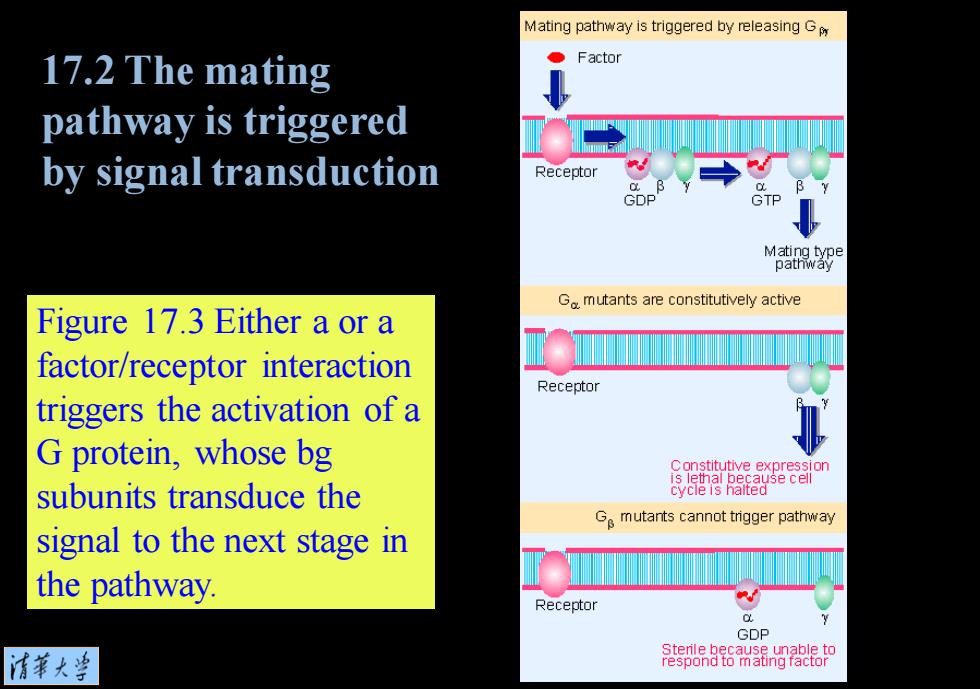
Mating pathway is triggered by releasing G 17.2 The mating Factor pathway is triggered by signal transduction Receptor GTP M盟,xe G mutants are constitutively active Figure 17.3 Either a or a factor/receptor interaction Receptor triggers the activation of a G protein,whose bg subunits transduce the Gmutants cannot trigger pathway signal to the next stage in the pathway. Receptor GDP 清菜大兰 品5品P
Figure 17.3 Either a or a factor/receptor interaction triggers the activation of a G protein, whose bg subunits transduce the signal to the next stage in the pathway. 17.2 The mating pathway is triggered by signal transduction
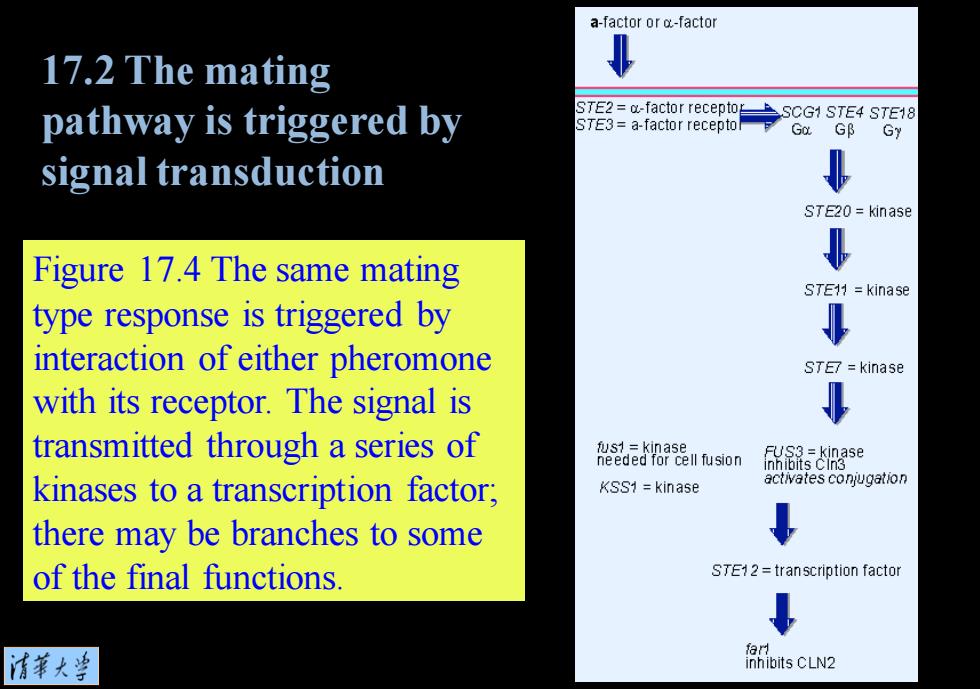
a-factor or o-factor 17.2 The mating pathway is triggered by STE2=a-factor receptoSCG1 STE4 STE18 S7E3=a-factor recepto GG阝 Gy signal transduction STE20=kinase Figure 17.4 The same mating 业 STE11 =kinase type response is triggered by ↓ interaction of either pheromone STE7 kinase with its receptor.The signal is ↓ transmitted through a series of fus1=kinase needed for cell fusion 品sse kinases to a transcription factor; KSS1 kinase activates conjugation there may be branches to some of the final functions. STE12 transcription factor farl 情菜大当 inhibits CLN2
Figure 17.4 The same mating type response is triggered by interaction of either pheromone with its receptor. The signal is transmitted through a series of kinases to a transcription factor; there may be branches to some of the final functions. 17.2 The mating pathway is triggered by signal transduction

17.2 The mating pathway is triggered by signal transduction Mammal Fly Wom 怡at Extracellular counter-receptor Membrane Tyrosine kinase Sevenless let-23 receptor receptor receptor Mating facor receptor recentor Cyt osolic Grb2 sem-5 com ponents GAP1 STE23GB7 Ras Ras1 et-60 ST E20 ME KK ST E11 c-Raf D-raf let-45 MEK D-sor ST E7 MAP kinase FUS3 KSS1 Nudear STE12 FARI effectors Figure 26.29 Homologous proteins are found in signal transduction cascades in a wide variety of organisms. 清苇大当
Figure 26.29 Homologous proteins are found in signal transduction cascades in a wide variety of organisms. 17.2 The mating pathway is triggered by signal transduction
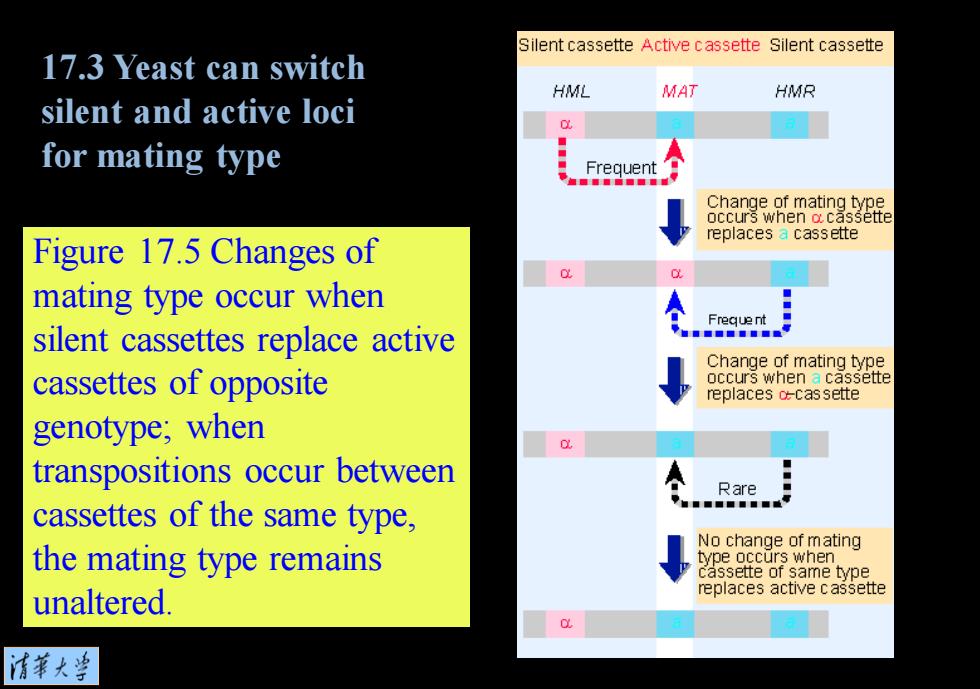
Silent cassette Active cassette Silent cassette 17.3 Yeast can switch HML MAT HMR silent and active loci for mating type Change of mating type occurs when a cassette replaces a cassette Figure 17.5 Changes of 0 mating type occur when Freque nt silent cassettes replace active 级量■■■量细数数 Change of mating type cassettes of opposite occurs when a cassette replaces ocas sette genotype;when transpositions occur between Rare cassettes of the same type, 如■■■■■ No change of mating the mating type remains type occurs when cassette of same type unaltered. replaces active cassette 清菜大当
Figure 17.5 Changes of mating type occur when silent cassettes replace active cassettes of opposite genotype; when transpositions occur between cassettes of the same type, the mating type remains unaltered. 17.3 Yeast can switch silent and active loci for mating type